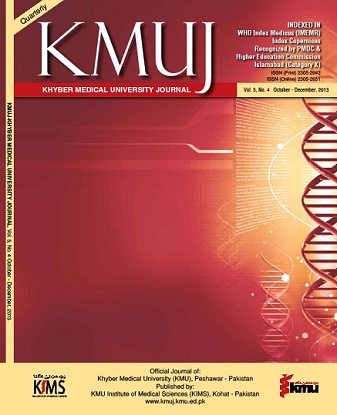PREVALENCE AND PREDETERMINANTS OF MALNUTRITION IN CHILDREN UNDER 3 YEARS OF AGE IN THE TWO RURAL COMMUNITIES OF PESHAWAR
Main Article Content
Abstract
OBJECTIVE: To determine the prevalence of malnourishment, socioeconomicand maternal factors leading to malnourishment in children of less than 3 years of age in the two rural communities of Peshawar.
METHODOLOGY: This descriptive, cross sectional study was conducted in two rural areas of Peshawar from June to July 2012. The respondents were selected using a multistage sampling technique in order to get true representation of the population. A pre-tested structured questionnaire was used to conduct face-to-face interviews with mothers and weight of the < 3 years old children was recorded.
RESULTS: Out of 200 children, 121 (60.5%) were males and 79 (39.5%) were females. Malnutrition was observed in 70 (35%) children, majority(n=50; 71.4%) of which were in the age group 0-2 years. Out of 70 malnourished children, 17(24.3%) were in grade 1 category, 23 (32.8%) in grade II category while 30 (42.8%) children were in grade III malnutrition. Socioeconomic factors leading to malnutrition were large family size (n=61; 87.1%), poor socioeconomic status (n=47/70; 67.1%) and illiteracy of the mother (n=42; 60%). Maternal factors leading to malnutrition were younger age group (n=29; 41.42%) multi-parity of the mother (n=39; 55.7%) and maternal anemia (n=51; 72.8%).
CONCLUSION: The prevalence of malnutrition in the two rural areas of Peshawar is 35% in children under three years of age. Both socioeconomicand maternal factors were responsible for its high prevalence. A multidisciplinary approach is required to combat malnutrition in these communities of Peshawar.
Article Details
Work published in KMUJ is licensed under a
Creative Commons Attribution 4.0 License
Authors are permitted and encouraged to post their work online (e.g., in institutional repositories or on their website) prior to and during the submission process, as it can lead to productive exchanges, as well as earlier and greater citation of published work.
(e.g., in institutional repositories or on their website) prior to and during the submission process, as it can lead to productive exchanges, as well as earlier and greater citation of published work.
References
Pakistan Census Organization. Available from URL: http://www.census.gov.pk/index.php (Cited on Jan 02, 2013).
Planning Commission, Government of Pakistan,
Pakistan Institute of Development Economics. National Nutrition Survey 2001. Islamabad: Planning Commission, Government of Pakistan.
UNICEF 2013 report. Improving Child Nutrition: The achievable imperative for global progress. Available from URL: http://www.unicef.org/publications/index_
html (Cited on October 30, 2013).
Neumann CG, Gewa C, Bwibo NO. Child nutrition in developing countries. Pediatr Ann 2004; 33: 658-74.
Muller O, Krawinkel M. Malnutrition and health in developing countries. Can Med Assoc J 2005; 173: 279-86.
De Onis M, Frongillo EA, Blossner M. Is malnutrition declining? An analysis of changes in levels of child malnutrition since 1980. Bull World Health Organ 2000; 78: 1222-33.
Daily Dawn Islamabad. August 22, 2013. Launching ceremony of a report titled ‘the Lancet Series on Maternal and Child Nutrition in Pakistan’ on Wednesday August 21, 2013, report was prepared by a nongovernment organisation, “Save the Children” in collaboration with the Agha Khan University (AKU).
Chaudhury RL. Determinants of dietary intake and dietary adequacy for pre-school children in Bangladesh. Food Nutr Bull 1984; 6(4): 24-33.
Mujib SA, Kazmi T, Khan S, Shad MA, Bashir M, Khan B. Relationship of non-organic
factors with malnutrition among children under three years of age. J Coll Physicians Surg Pak 2006; 16(5): 355-8.
Kliegman RM, Behrman RE, Jenson HB, Stanton BF. (Edit). Nelson textbook of Paediatrics,
th edition. Sanders, Philiadilphil, 2012. 225-7.
WHO. Complementary feeding: Report of the global consultation convened jointly by the department of child and adolescent health and development and the department of nutrition for health and development, Geneva, 10-13 December2001 and Summary of guiding principles for complementary feeding of the breastfed
child. Geneva: WHO; 2002; Available from URL: http://www.who.int/child-adolescent-
health/publications/NUTRITION/Report_CF.htm (Cited on Jan 02, 2013).
Nestel P, Briend A, de Benoist B, Decker E, Ferguson E, Fontaine O, et al. Complementary
food supplements to achieve micronutrient adequacy for infants and young children. J Pediatr Gastroenterol Nutr. 2003; 36: 316-28.
Bhutta ZA. Effect of infections and environmental factors on growth and nutritional status in developing countries. J Pediatr Gastroenterol Nutr 2006; 43(Suppl
: S13-S21.
Smith LC, Haddad L. Explaining child malnutrition
in developing countries: A cross country analysis. International Food Policy Research Institute, Food Consumption and Nutrition Division discussion paper nr. 60; 2000.
Vella V, Tomkins A, Borghesi A, Migliori GB, Adriko BC, Crevatin E. Determinants
of child nutrition in north-west Uganda. Bulletin of the World Health Organization 1992; 70: 637-647.
Heaton T, Forste R, Hoffmann J, Flake D. Cross-national variation in family influences
on child health. Social Sci Med 2005; 60: 97-108.
Brakohiapa LA, Yartey J, Bille A, Harrison E, Quansah E, Armar MA, et al. Does prolonged breastfeeding adversely affect a child’s nutritional status? Lancet. 1988; 332: 416-8.
Steketee RW, 2003. Pregnancy, nutrition and parasitic diseases. J Nutr 133 (Suppl 2): 1661S-1667S.
Dewey KG. Nutrition survey in Tabasco, Mexico: nutritional status of preschool children. Am J Clin Nutr 1983; 37: 1010-19.
Aguillon DB, Caedo MM, Arnold JC, Engel RW. The relationship of family characteristics
to the nutritional status of pre-school children. Food Nutr Bull 1982; 4(4): 5-12.
Popkin BM. Time allocation of the mother and child nutrition. Ecol Food Nutr 1980; 9: 1-14.
Grewal T. Gopaldas T. Gadre VJ. Etiology of malnutrition in rural Indian preschool children (Madhya Pradesh). J Trop Pediatr Environ Child Health 1973; 19(3): 265-70.
